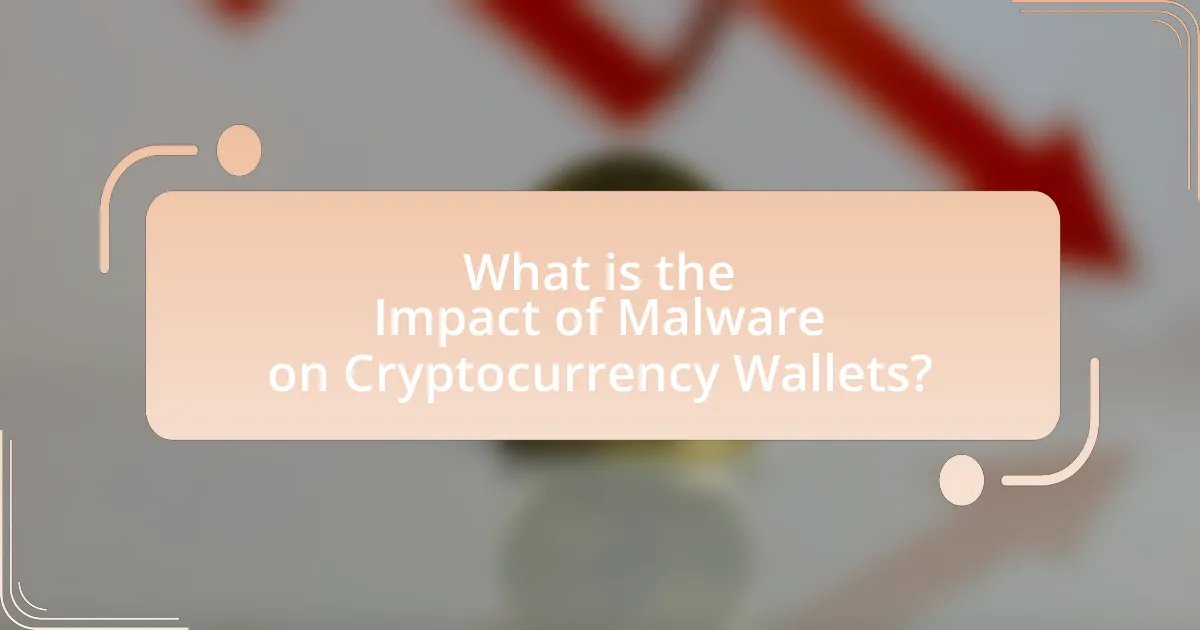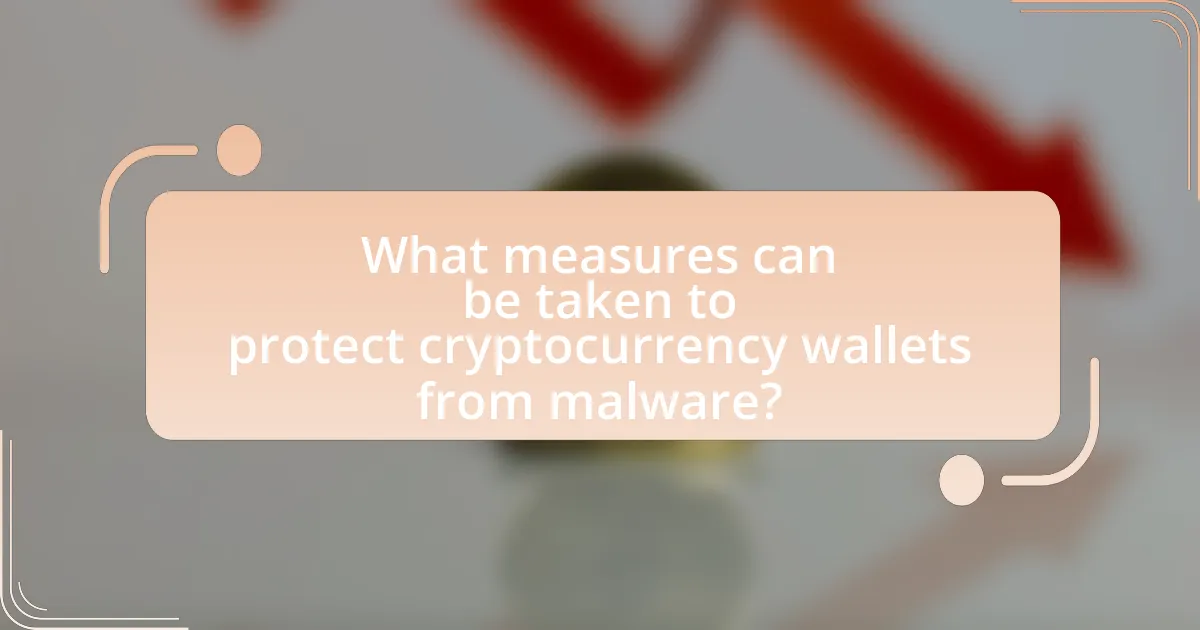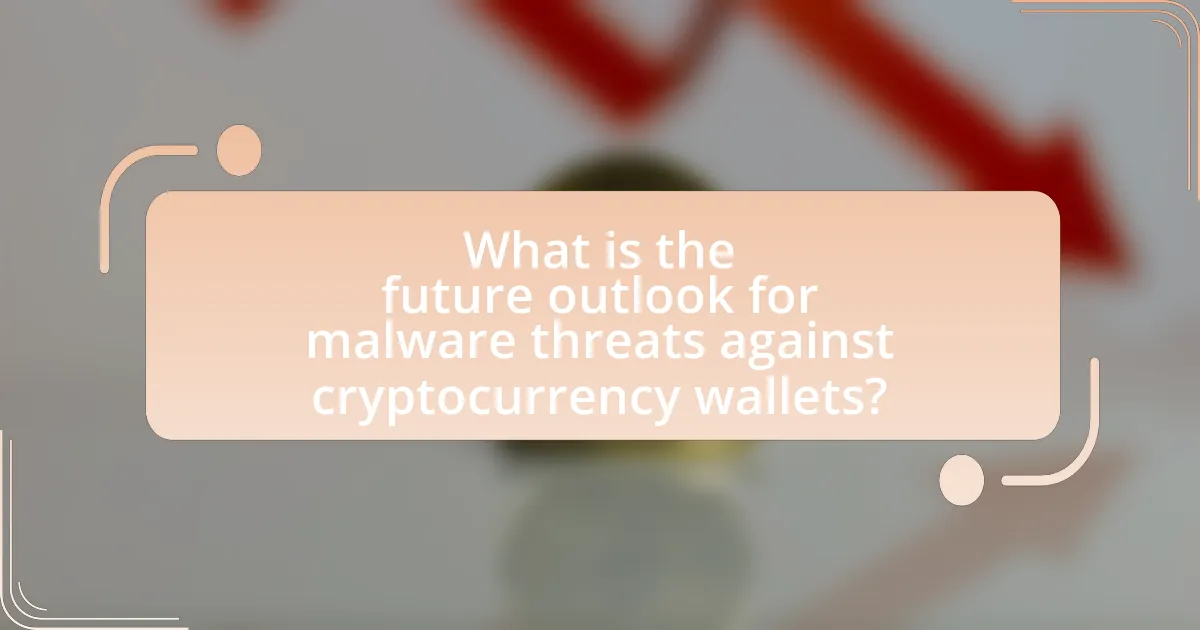Malware poses a significant threat to the security of cryptocurrency wallets, enabling unauthorized access to private keys and sensitive information, which can result in substantial financial losses for users. Techniques such as keylogging, phishing, and exploiting software vulnerabilities are commonly employed by malware to compromise wallets. The article examines the various types of malware targeting cryptocurrency wallets, the potential consequences of these attacks, and the long-term effects on user trust in digital currencies. Additionally, it outlines effective security measures users can implement to protect their wallets, including the use of hardware wallets, two-factor authentication, and regular software updates, while also addressing emerging trends in malware and the importance of staying informed about evolving threats.

What is the Impact of Malware on Cryptocurrency Wallets?
Malware significantly compromises the security of cryptocurrency wallets by enabling unauthorized access to private keys and sensitive information. This unauthorized access can lead to the theft of funds, as malware often captures keystrokes or takes screenshots to gather user credentials. According to a report by the cybersecurity firm Cybereason, in 2020, over $1.8 billion worth of cryptocurrency was stolen due to malware attacks, highlighting the severe financial implications for users. Additionally, malware can also manipulate wallet software, causing users to unknowingly send funds to attackers instead of intended recipients.
How does malware specifically target cryptocurrency wallets?
Malware specifically targets cryptocurrency wallets by employing techniques such as keylogging, phishing, and exploiting vulnerabilities in wallet software. Keyloggers capture keystrokes to obtain private keys or passwords, while phishing attacks trick users into revealing sensitive information through fake websites or emails. Additionally, malware can exploit software vulnerabilities to gain unauthorized access to wallets, allowing attackers to transfer funds without user consent. For instance, a report by the cybersecurity firm ESET highlighted that in 2020, over 7,000 unique phishing sites were created to target cryptocurrency users, demonstrating the prevalence of these tactics.
What types of malware are most commonly used against cryptocurrency wallets?
The most commonly used types of malware against cryptocurrency wallets include keyloggers, phishing malware, and ransomware. Keyloggers capture keystrokes to steal sensitive information such as private keys and passwords. Phishing malware tricks users into revealing their credentials through fake websites or emails, leading to unauthorized access to wallets. Ransomware can encrypt wallet files and demand payment for their release, directly impacting users’ access to their funds. According to a report by Cybersecurity Ventures, the rise in cryptocurrency-related cybercrime has led to increased targeting of wallets by these malware types, highlighting the need for robust security measures.
How do these malware types exploit vulnerabilities in wallets?
Malware types exploit vulnerabilities in cryptocurrency wallets primarily through techniques such as keylogging, phishing, and exploiting software flaws. Keylogging malware captures keystrokes, allowing attackers to obtain private keys or passwords used to access wallets. Phishing attacks trick users into revealing sensitive information by mimicking legitimate wallet interfaces or communications. Additionally, malware can exploit software vulnerabilities in wallet applications, enabling unauthorized access or manipulation of wallet data. For instance, a study by the Cybersecurity and Infrastructure Security Agency (CISA) highlighted that vulnerabilities in wallet software can lead to unauthorized transactions, resulting in significant financial losses for users.
What are the potential consequences of malware attacks on cryptocurrency wallets?
Malware attacks on cryptocurrency wallets can lead to significant financial losses for users. These attacks often result in unauthorized access to wallet private keys, enabling cybercriminals to transfer funds without the owner’s consent. For instance, a report by the cybersecurity firm Chainalysis indicated that in 2021, over $2.8 billion was stolen from cryptocurrency wallets due to various forms of malware, highlighting the severe financial impact. Additionally, malware can compromise personal information, leading to identity theft and further financial repercussions. The consequences extend beyond immediate theft, as victims may face long-term issues such as loss of trust in digital currencies and increased vulnerability to future attacks.
How can malware lead to the loss of funds in cryptocurrency wallets?
Malware can lead to the loss of funds in cryptocurrency wallets by compromising the security of the wallet software and enabling unauthorized access to private keys. When malware infects a device, it can capture sensitive information, such as passwords and private keys, which are essential for accessing and managing cryptocurrency wallets. For instance, keyloggers can record keystrokes, while clipboard hijackers can replace wallet addresses copied to the clipboard with those controlled by the attacker. According to a report by the cybersecurity firm Cybereason, malware attacks targeting cryptocurrency wallets increased by 300% in 2021, highlighting the growing threat to users’ funds.
What are the long-term effects on users’ trust in cryptocurrency systems?
The long-term effects on users’ trust in cryptocurrency systems are generally negative, primarily due to security breaches and malware incidents. Research indicates that high-profile hacks, such as the Mt. Gox incident in 2014, resulted in the loss of approximately 850,000 Bitcoins, significantly eroding user confidence. Additionally, a study by the Cambridge Centre for Alternative Finance found that 25% of cryptocurrency users reported concerns about security, which directly impacts their willingness to engage with these systems over time. As malware continues to target cryptocurrency wallets, the persistent threat contributes to a growing skepticism among users regarding the safety and reliability of these platforms.

What measures can be taken to protect cryptocurrency wallets from malware?
To protect cryptocurrency wallets from malware, users should implement strong security practices such as using hardware wallets, enabling two-factor authentication, and regularly updating software. Hardware wallets store private keys offline, significantly reducing exposure to malware attacks. Two-factor authentication adds an extra layer of security by requiring a second form of verification, making unauthorized access more difficult. Regular software updates ensure that any vulnerabilities are patched, reducing the risk of exploitation by malware. According to a report by the Cybersecurity and Infrastructure Security Agency, using these measures can significantly decrease the likelihood of successful malware attacks on cryptocurrency wallets.
How can users enhance the security of their cryptocurrency wallets?
Users can enhance the security of their cryptocurrency wallets by implementing multi-factor authentication (MFA). MFA adds an extra layer of protection by requiring not only a password but also a second form of verification, such as a text message code or an authentication app. According to a study by the Cybersecurity & Infrastructure Security Agency, using MFA can block up to 99.9% of automated attacks, significantly reducing the risk of unauthorized access to wallets. Additionally, users should regularly update their wallet software to patch vulnerabilities, utilize hardware wallets for offline storage, and avoid public Wi-Fi networks when accessing their wallets to further mitigate security risks.
What role do software updates play in wallet security?
Software updates play a critical role in wallet security by providing essential patches and enhancements that protect against vulnerabilities. These updates often address newly discovered security flaws that could be exploited by malware, thereby reducing the risk of unauthorized access to cryptocurrency wallets. For instance, a 2021 report by the Cybersecurity and Infrastructure Security Agency highlighted that timely software updates can mitigate up to 85% of known vulnerabilities, emphasizing their importance in maintaining wallet integrity and user safety.
How effective are two-factor authentication methods against malware?
Two-factor authentication (2FA) methods are highly effective against malware, as they add an additional layer of security beyond just a password. By requiring a second form of verification, such as a code sent to a mobile device, 2FA significantly reduces the risk of unauthorized access, even if a password is compromised. Research indicates that accounts protected by 2FA are 99.9% less likely to be compromised compared to those that rely solely on passwords. This effectiveness is particularly crucial in the context of cryptocurrency wallets, where malware can target private keys and sensitive information. Therefore, implementing 2FA can greatly enhance the security of cryptocurrency wallets against malware attacks.
What best practices should users follow to avoid malware infections?
To avoid malware infections, users should implement robust cybersecurity measures. These measures include regularly updating software and operating systems to patch vulnerabilities, using reputable antivirus and anti-malware programs to detect and eliminate threats, and avoiding clicking on suspicious links or downloading attachments from unknown sources. According to the Cybersecurity & Infrastructure Security Agency (CISA), keeping software up to date can reduce the risk of exploitation by 85%. Additionally, employing strong, unique passwords and enabling two-factor authentication adds layers of security that significantly decrease the likelihood of unauthorized access.
How can users identify phishing attempts targeting their wallets?
Users can identify phishing attempts targeting their wallets by scrutinizing the authenticity of communication and website URLs. Phishing attempts often involve emails or messages that create a sense of urgency, prompting users to click on links that lead to fraudulent websites designed to mimic legitimate wallet services. For instance, legitimate wallet providers will use secure URLs that begin with “https://” and have a recognizable domain name. According to a report by the Anti-Phishing Working Group, there were over 200,000 phishing attacks reported in the first quarter of 2023, highlighting the prevalence of such threats. Users should also be wary of unsolicited requests for personal information or private keys, as legitimate services will never ask for sensitive data through insecure channels.
What are the recommended security tools for cryptocurrency wallet protection?
The recommended security tools for cryptocurrency wallet protection include hardware wallets, software wallets with strong encryption, two-factor authentication (2FA), and antivirus software. Hardware wallets, such as Ledger and Trezor, store private keys offline, significantly reducing the risk of malware attacks. Software wallets, like Exodus and Electrum, should utilize robust encryption methods to safeguard user data. Implementing 2FA adds an additional layer of security by requiring a second form of verification during transactions. Furthermore, antivirus software helps detect and eliminate malware threats that could compromise wallet security. These tools collectively enhance the protection of cryptocurrency wallets against malware and other cyber threats.

What is the future outlook for malware threats against cryptocurrency wallets?
The future outlook for malware threats against cryptocurrency wallets is increasingly concerning, as cybercriminals are expected to develop more sophisticated techniques to exploit vulnerabilities. Research indicates that the rise in cryptocurrency adoption will likely attract more attackers, leading to a projected increase in targeted malware attacks. For instance, a report by Cybersecurity Ventures predicts that global cybercrime costs will reach $10.5 trillion annually by 2025, highlighting the financial incentive for criminals to target cryptocurrency wallets specifically. Additionally, the emergence of decentralized finance (DeFi) platforms creates new attack vectors, making it essential for users to adopt robust security measures to protect their assets.
How is the evolution of malware impacting cryptocurrency wallet security?
The evolution of malware significantly undermines cryptocurrency wallet security by introducing increasingly sophisticated attack vectors. As malware evolves, it has become more adept at targeting vulnerabilities in wallet software, leading to higher rates of theft and unauthorized access. For instance, according to a report by Cybersecurity Ventures, cybercrime, including malware attacks, is projected to cost the world $10.5 trillion annually by 2025, highlighting the financial impact of these threats. Additionally, the rise of advanced persistent threats (APTs) and ransomware specifically designed to exploit cryptocurrency wallets has been documented, with incidents such as the 2021 Colonial Pipeline ransomware attack illustrating the potential for significant financial loss. This ongoing evolution necessitates continuous updates and improvements in wallet security measures to mitigate risks effectively.
What emerging trends in malware should cryptocurrency users be aware of?
Emerging trends in malware that cryptocurrency users should be aware of include ransomware targeting crypto wallets, phishing attacks through fake wallet applications, and cryptojacking. Ransomware has evolved to specifically target cryptocurrency wallets, demanding payment in digital currencies to unlock access. Phishing attacks have become more sophisticated, with attackers creating counterfeit wallet applications that mimic legitimate ones to steal private keys. Cryptojacking, where malware hijacks a user’s computer to mine cryptocurrency without their consent, has also surged, exploiting users’ resources for profit. According to a report by Cybersecurity Ventures, ransomware attacks are projected to cost businesses over $20 billion by 2021, highlighting the financial impact of these threats.
How can the cryptocurrency community respond to evolving malware threats?
The cryptocurrency community can respond to evolving malware threats by implementing robust security measures, such as multi-factor authentication and regular software updates. These strategies enhance wallet security and reduce vulnerabilities that malware exploits. For instance, a report by Cybersecurity Ventures indicates that cybercrime, including malware attacks, is projected to cost the world $10.5 trillion annually by 2025, highlighting the urgency for proactive measures. Additionally, educating users about phishing attacks and safe online practices can significantly mitigate risks associated with malware.
What practical steps can users take to safeguard their cryptocurrency wallets today?
To safeguard cryptocurrency wallets today, users should implement strong security measures such as enabling two-factor authentication (2FA), using hardware wallets, and regularly updating software. Two-factor authentication adds an extra layer of security by requiring a second form of verification, significantly reducing the risk of unauthorized access. Hardware wallets, which store private keys offline, protect against malware attacks that target online wallets. Regularly updating wallet software ensures that users benefit from the latest security patches, addressing vulnerabilities that could be exploited by malware. These steps are essential in mitigating the risks associated with malware, which has been shown to compromise numerous cryptocurrency wallets in recent years.
What immediate actions should users implement to enhance wallet security?
To enhance wallet security, users should immediately enable two-factor authentication (2FA) on their wallets. This additional layer of security requires not only a password but also a second form of verification, significantly reducing the risk of unauthorized access. According to a study by Google, 2FA can block 99.9% of automated attacks, demonstrating its effectiveness in protecting sensitive information. Additionally, users should regularly update their wallet software to patch vulnerabilities and utilize strong, unique passwords to further safeguard their accounts.
How can users stay informed about the latest malware threats and defenses?
Users can stay informed about the latest malware threats and defenses by regularly following cybersecurity news outlets, subscribing to threat intelligence feeds, and participating in online security forums. Cybersecurity news outlets like Krebs on Security and Threatpost provide timely updates on emerging threats, while threat intelligence feeds from organizations such as the Cyber Threat Alliance offer real-time data on malware activity. Additionally, engaging in online security forums, such as those on Reddit or specialized platforms like BleepingComputer, allows users to share experiences and learn from others about the latest defenses against malware.